

is a wholesale Mortgage Broker committed to providing our clients with great customer service combined with great rates. And because an offset account otherwise works like a typical bank account, you can easily withdraw money from the account when you need it, giving you some extra financial flexibility.Welcome to Principle Mortgage Group, Inc. The difference is that the money you deposit in your offset account is included when calculating the interest charges on your home loan effectively ‘offsetting’ your mortgage principal.įor example, if you owed $500,000 on your home loan, and had $50,000 saved in your offset account, you’d be charged interest on your home loan as if you only owed $450,000.Īn offset account can offer similar benefits to making extra repayments on your home loan, as by lowering your interest charges, more of each home loan repayment can go towards paying off your mortgage principal. Just like most other bank accounts, you can deposit and withdraw money to and from your offset account as often as you like, and access your money via debit cards, online banking apps, and ATMs. Plus, some lenders may put limits on redraws or charge fees to redraw extra repayments.Īn offset account is a bank account that’s linked to your home loan. While this can put extra cash back in your hands when you need it, it can undo some of the good work reducing your interest charges. However, some lenders offer a redraw facility, which lets you access extra repayments you made previously. It’s also important to remember that using your savings to make extra mortgage repayments means this money won’t be available to you in case of emergencies. Some lenders will cap how much you can make in extra repayments per year, or charge fees for making extra repayments. Keep in mind that not every home loan will allow unlimited extra repayments – for example, fixed rate home loans are more likely to require you to stick to the repayment schedule, at least during the fixed rate period. The more you can shrink your interest charges, the more of each home loan repayment can go towards paying off your outstanding principal amount, accelerating your progress towards paying off your mortgage.
Principal is the money used to pay down the balance of.

This means that the more often you can make extra repayments and lower your outstanding mortgage balance, the more you can shrink your interest charges, even if only by a tiny amount at a time. Principal, Interest, Taxes, Insurance - PITI: Principal, Interest, Taxes, Insurance (PITI) refers to the components of a mortgage payment. Most mortgage lenders charge interest monthly, fortnightly or weekly with your mortgage repayments, interest is often calculated on a daily basis. If your lender allows you to make extra repayments onto your home loan in addition to the scheduled repayments, this extra money can go straight towards paying off your mortgage principal. But over time, the ratio gradually shifts in the other direction, with each repayment paying off more of your remaining principal. Looking at a breakdown of a home loan’s repayments over time, you may notice that in the beginning the majority of each repayment is made up of interest, with a smaller amount going towards paying off the principal. The simplest way to pay off the principal on your mortgage is to make regular principal and interest mortgage repayments. Your equity is how much of your property you own outright, and may be useful when refinancing your home loan, investing in a second property, or accessing a line of credit. Your equity is the current value of the property, minus the outstanding mortgage principal. Your mortgage principal is also used to work out your equity in a property. The less principal that’s owing on your loan, the less interest you’ll be charged that month (or fortnight, or week). Your home loan’s principal is important because it is used to calculate the interest charges that make up your home loan repayment.
#PRINCIPAL OR PRINCIPLE FOR LOANS PLUS#
When your mortgage application is approved, you agree to repay your mortgage principal plus interest charges in regular instalments over the loan term, which is often measured in decades. With fixed-rate mortgages, your monthly payment is.

Your mortgage principal is another name for the money you owe your lender on your home loan. The principal is the amount of the loan itself and the interest is the monthly amount that the lender charges you on top of the principal.


 0 kommentar(er)
0 kommentar(er)
